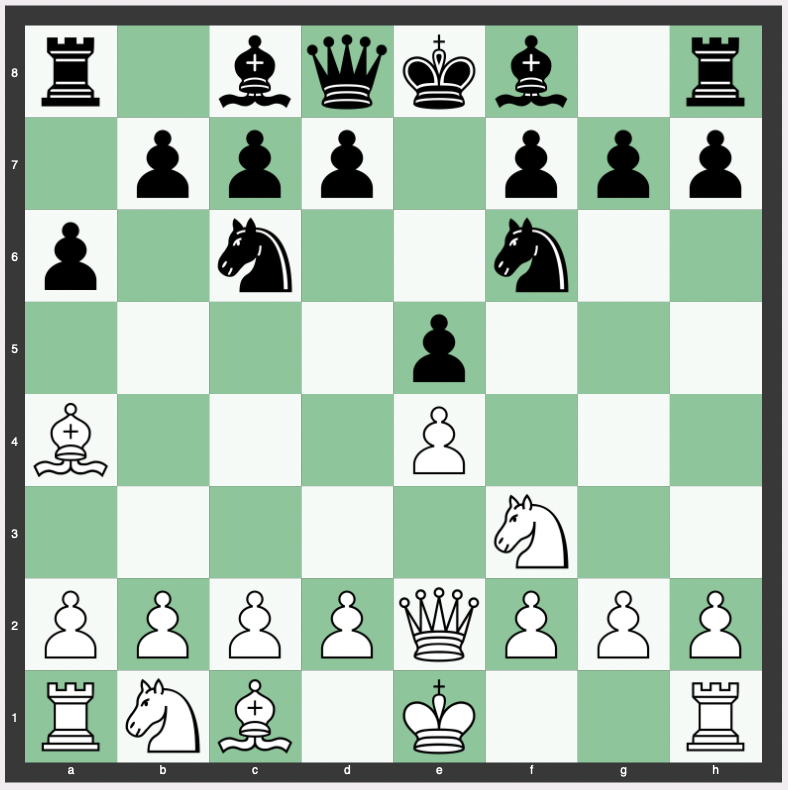One interesting and distinctive variation in the Ruy Lopez opening is the Wormald Variation, which emerges after the moves 1. e4 e5 2. Nf3 Nc6 3. Bb5 a6 4. Ba4 Nf6 5. Qe2.
Here we look at the Wormald Variation of the Ruy Lopez in depth, providing insights into its move order, theory, strategy, and purpose, as well as its historical context and relevance to both beginner and intermediate players.
Move Order of the Wormald Variation
The move order of the Wormald Variation is as follows: 1. e4 e5 2. Nf3 Nc6 3. Bb5 a6 4. Ba4 Nf6 5. Qe2.

This variation comes about when white chooses to break from the traditional Ruy Lopez move of 5. O-O, and instead opts to develop the queen early to e2.
Theory, Strategy and Purpose of the Wormald Variation
The primary purpose of the Wormald Variation, indicated by the move 5. Qe2, is to prepare for a quick d2-d4, challenging black’s pawn on e5.
In this position, the queen also indirectly defends the e4 pawn.
This setup allows white to sidestep some of the main lines of the Ruy Lopez where black initiates early complications.
A downside to the Wormald Variation, however, is that the queen’s early development to e2 can interfere with the natural development of white’s minor pieces, particularly the knight’s access to d2.
Variations of the Wormald
Several variations can stem from the Wormald Variation, largely dependent on black’s response.
5…b5
One possible reply is 5…b5, after which the bishop typically retreats to b3 (6.Bb3).
Sample continuation lines include:
5… b5 6. Bb3 Bc5 7. a4 Na5 8. Ba2 O-O 9. d3 Re8 10. axb5 axb5 11. O-O b4 12. Be3 Bf8 13. Ng5 d5 14. exd5
5… b5 6. Bb3 Bc5 7. c3 O-O 8. O-O d6 9. h3 Ba7 10. Rd1 Re8 11. d3 Ne7 12. a4 Bb7 13. Be3 Bxe3 14. fxe3 Ng6 15. Nbd2 d5 16. exd5 Bxd5 17. Bxd5 Qxd5
5… b5 6. Bb3 Bc5 7. c3 d6 8. d3 h6 9. O-O O-O 10. h3 Rb8 11. Rd1 Re8 12. Nbd2 Bb6 13. Nf1 Ne7 14. Ng3 c5 15. Nh4 d5 16. exd5 g5 17. Qxe5 Nexd5
5… b5 6. Bb3 Bc5 7. a4 Na5 8. Ba2 O-O 9. O-O d6 10. d3 h6 11. axb5 axb5 12. Be3 Bxe3 13. fxe3 Bd7 14. Nc3 b4 15. Nd5 Nxd5 16. Bxd5 c6 17. Ba2 b3 18. cxb3 Qb6 19. b4 Qxb4
This position is considered slightly worse for white.
5…Bc5
This puts pressure on the f2 square and is a staple in many Ruy Lopez lines for black.
Sample continuation lines include:
6. Bxc6 bxc6 7. Nxe5 O-O 8. O-O Re8 9. d4 Bxd4 10. Nxf7 Kxf7 11. Qc4+ d5 12. Qxd4 Rxe4 13. Qc3 Qd6 14. Nd2 Re8 15. Nb3 a5 16. a4 Ba6 17. Rd1 Ne4 18. Qh3 Kg8 19. f3 Nc5 20. Nd4 Ne6 21. Nf5 Nf4 22. Bxf4 Qxf4 23. Re1 Qg5 24. Nd4 Qd2 25. Qh4 Qb4 26. c3 Qxb2 27. Nxc6 Qxc3 28. Ne7+ Kh8 29. Kh1 Bd3 30. Nxd5 Rxe1+ 31. Rxe1
6. Bxc6 bxc6 7. Nxe5 O-O 8. Nc3 Re8 9. Nxf7 Kxf7 10. Qc4+ d5 11. Qxc5 Nxe4 12. Nxe4 Rxe4+ 13. Kd1 Qh4 14. f3 Bf5 15. d3 Re5 16. g3 Qh3 17. Bf4 Qg2 18. Rg1 Qxf3+ 19. Kd2 Re2+ 20. Kc3 Rae8 21. b3 Rxh2 22. Rac1 Ree2 23. Rge1 Qf2 24. Qxf2 Rexf2 25. b4 Rhg2 26. Bxc7 d4+ 27. Kxd4 Rxc2 28. a4 Rxc1 29. Rxc1 Ra2 30. a5 Rd2
6. Bxc6 bxc6 7. Nxe5 O-O 8. Nc3 Re8 9. Nxf7 Kxf7 10. Qc4+ d5 11. Qxc5 Nxe4 12. Nxe4 Rxe4+ 13. Kd1 Qh4 14. f3 Bf5 15. d3 Re5 16. g3 Qh3 17. Bf4 Qg2 18. Rg1 Qxf3+ 19. Kd2 Re2+ 20. Kc3 Rae8 21. Rgd1 Rxh2 22. Bxc7 Ree2 23. Rac1 Qf2 24. Qxf2 Rhxf2 25. b4 g5 26. Rh1 Kg6 27. a4 h5
This position is considered slightly better for white.
History of the Wormald Variation
The Wormald Variation is named after Thomas Wormald, a 19th-century English chess player.
Although not as popular or well-studied as other variations of the Ruy Lopez, the Wormald Variation has a rich history and has been employed in several important historical matches.
Is the Wormald Variation Good for Beginners or Intermediates?
The Wormald Variation could be a reasonable choice for beginners or intermediate players looking to avoid the most well-trodden paths of the Ruy Lopez.
It offers a direct, clear plan that involves challenging the center early on.
However, it is important to understand that the 5. Qe2 move can lead to somewhat awkward piece coordination for white, so precise play is required to navigate the opening successfully.
How Often Is the Wormald Variation Played at the Grandmaster Level?
While the Wormald Variation is not the most popular choice in grandmaster play, it has been seen on occasion.
It tends to be employed as a surprise weapon rather than a mainstay of a player’s opening repertoire.
Notwithstanding, it’s a testament to the richness and diversity of chess that even these less common lines can be used effectively at the highest levels of play.
ECO C77 Ruy Lopez, Wormald attack, Gruenfeld Variation (White perspective)
Conclusion
The Wormald Variation of the Ruy Lopez provides an interesting and less common option in one of the oldest and most respected openings in chess.
With its unique move order and strategy, this variation offers a refreshing detour from the main lines, and can lead to dynamic, richly tactical games.
Whether you’re a beginner or intermediate player, or even a grandmaster looking for a surprise weapon, the Wormald Variation is a line worth considering and exploring.


